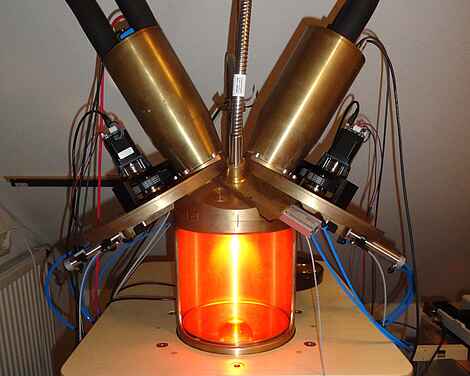Philipp Bokatius, Gudrun Mende, Matthias Rang & Peter Stolz
Installation and start-up of the FAS-2
After various technical challenges and subsequent delays in the project schedule (see the 2019–2022 annual reports), in January 2023 it was finally possible to move the nearly completed FAS-2 system into the air-conditioned darkroom at the KWALIS research institute and set it up next to the original FAS-1 system.
The new system was operated for the first time at the beginning of February 2023, with the measurement of the first apple. At this point, only one photomultiplier (PMT) was operational, the software was not yet fully functional, and the lamp housing had not yet been fully assembled. The lighting and control of the system still had to be done manually, but it was the first time that we were able to record the characteristic gradient of a weak fluorescence with the system – this was the first time that the anticipated high sensitivity of the new system could be confirmed in practice. The first “dark measurement”, i.e. the first measurement of the ultra-weak photo emission (UWPE) of the apple, could also be carried out on the same evening, after the fluorescence had subsided.
In May, after completion of the lamp housing and the control program, the system was ready for use in all measurement modes (initially limited to one PMT) and released for test operations with real samples in biophysics. The second PMT was set up in June and the system became fully functional. Initial measurements of the color and spectral resolution of the sample light emission (EmSpec) were carried out.
Comparative measurements, characterization of the FAS-2 and prospects
To assess measurement results, it is particularly valuable to be able to compare them with the measurement results of an independent system. This was possible in August 2023, after the original FAS-1 system was repaired by Jürgen Strube. It was shown that in both systems the characteristic differences between two samples occur in the same parameters, although the spectral sensitivity of the photocathodes of the PMTs and the signal path of the two systems differ. For example, the differentiation of products from biodynamic and conventional production (e.g. chicken eggs) can be repeated with statistical significance using both systems and carried out with the same parameters.
In October and November, the new FAS-2 system was then technically characterized after approximately fifteen thousand measurement curves had been taken during the second half of the year. It turned out that we were able to implement all the technical objectives set out in the research project application in the final system and thus successfully conclude the cooperative project between KWALIS and the Natural Sciences Section at the end of the year.
A follow-up project is already being applied for, which will involve working on experimental questions with the new system (including the question of whether F1 hybrids differ from breeding lines without hybridization in sample light emission). We are particularly pleased to be able to use the new capabilities of the FAS-2, such as determining the wavelength ranges in addition to the intensity of the light emission, which will be possible for the first time.
Or via Bank Transfer:
| CHF | EUR | |
| Allgemeine Anthroposophische Gesellschaft Postfach, 4143 Dornach/Schweiz Raiffeisenbank Dornach, CH–4143 Dornach BIC: RAIFCH22 IBAN: CH54 8080 8001 1975 4658 2 ⇨ Payment Purpose: KST 1111 | Allgemeine Anthroposophische Gesellschaft Postfach, 4143 Dornach/Schweiz GLS Gemeinschaftsbank eG, DE-44708 Bochum BIC: GENODEM1GLS IBAN: DE53 4306 0967 0000 9881 00 ⇨ Payment Purpose: KST 1111 |
